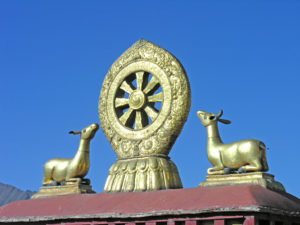The Thirty-Two Marks of the Buddha is a misnomer of monumental proportions. They are taken from early pre-Buddhist Indian writings. There they were called the Thirty-Two Marks of a Great Man. In an ancient Indian text, the Lakshana Sutra are described. The markings or forms of the body were considered a result of acts of good Karma in other reincarnations. It is certain that during that time if a member of the lower castes or a woman had all thirty-three marks they still wouldn’t have been called a great man, or even just a man.
History of Guatama
The history of Guatama before he became the Enlightened One says that the sage Ashita visited the palace soon after Guatama’s birth. He recognized all thirty-two marks and foresaw that the baby would grow to be a renowned king or a world-worshipped holy man. Would he have said that if those signs had shown on a leper? Many Buddhist scholars believe that this parable was added to the Sutras much later.
 Buddha is quoted as saying in the Avatamsaka Sutra, “The thirty-two marks belong to the response and transformation bodies, and certainly not to the Buddha’s Dharma body.” This could be understood to mean that physical manifestations would not indicate a person’s ability to recognize their Buddhahood.
Buddha is quoted as saying in the Avatamsaka Sutra, “The thirty-two marks belong to the response and transformation bodies, and certainly not to the Buddha’s Dharma body.” This could be understood to mean that physical manifestations would not indicate a person’s ability to recognize their Buddhahood.
Some of the distinguishing characteristics come from animals and other earthly things. Below they are grouped per area of the body.
Feet have level tread. Dharma wheels on the soles of the feet. Projecting heels. Long fingers and toes. Feet that are soft and tender. Webbed hands and feet. Ankles in the form of rounded shells.
Arms long enough to touch knees without bending. Antelope like legs.
Male organ sheathed in flesh.
The complexion is golden. Dust never sticks to the delicate skin. Body hair grows singly from each pore. Down is blue-black in color.
The posture of his body is straight. It has seven convex surfaces. Lion shaped front half. No furrow between the shoulder blades. The symmetry of a Banyan tree. Equally rounded bust.
The jaws of a lion. Forty teeth. Regular teeth. Continuous teeth. Eyeteeth are very lustrous. His tongue is long.
A divine voice.
Intense blue eyes. Eyelashes like a cow. A hairy mole (urna) between his brows.
A head shaped like a turban with a bump in the center (ushnisha).
Put all these together and try to picture a holy man.
Certainly, Guatama had some of these characteristics and may have developed more throughout his life. Many of them would make him a mythological creature instead of the man of peace and compassion he is known to have been. It is not marked that make a being express their Buddha-nature.





